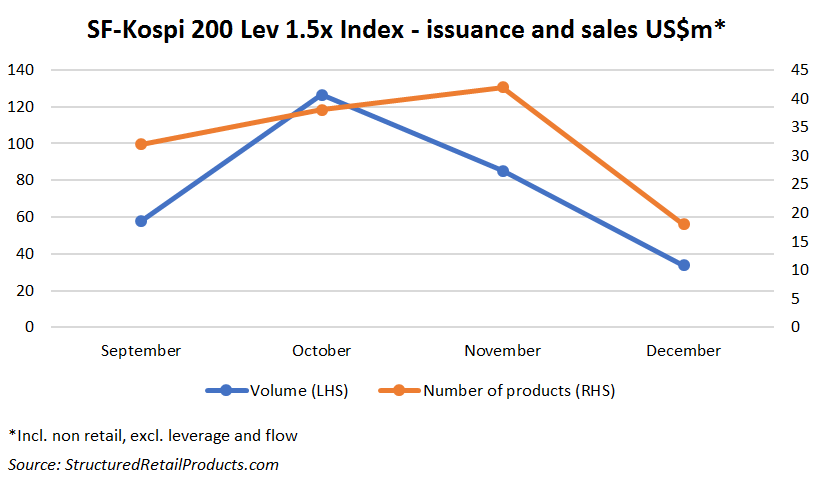The Korea Exchange (KRX) has outlined plans to further promote Kospi products, following the rolling out on July 24, 2017 of the SF-Kospi 200 Leverage 1.5X (S: Spot, F: Futures), nicknamed Kospi 3 for marketing purposes. From September 2017 to November 2017, issuance linked to the Kospi 3 reached over US$280m through the major distribution channels in Korea.
Although equity underlyings have largely dominated autocallable issuance to date, Natixis had seen an increasing appetite for autocall features on new asset classes, such as rates or foreign exchange. With South Korea one of the largest autocallables markets in the world, Natixis and the Korea Exchange embarked on joint-venture to create a new benchmark.
The new index can be checked in real-time on the exchange's website, Bloomberg and Reuters, while Google Finance has plans to provide the same data. "The existing index line-up is focused on domestic equity indices and global market expansion is still in the initial stage," said Kwon Oh-Hyun (pictured), executive director of KRX. "Therefore, KRX will diversify the range of index underlyings including fixed-income securities and derivatives. It will also expand its businesses to overseas with other exchanges and global index providers."
The bank first proposed enhanced coupon levels on autocallable structures through dividends. From the Kospi 200 stocks, the French bank came up with a basket of high dividend/high liquidity stocks on which a new index could be built, while also introducing the concept of 'synthetic dividend', which means that a pre-determined dividend amount is withdrawn from the original basket on daily basis. Although synthetic dividend avoids the uncertainty of annual dividend forecast which improves pricing, the concept was very new to Korean investors and the KRX passed on the idea.
Instead, the exchange proposed increasing the volatility of the underlying index to increase any potential coupons. Korean investors are familiar with leverage from using Kospi 200 futures, and the exchange suggested using a two-times leverage of these futures as an underlying index. However, a leverage index might have "yield erosion effect" and large loss potential if the position is held for a long term, according to Samuel Plagnard, head of fixed income sales and financing engineering at Natixis in Asia Pacific. After examination, the erosion effect of a two-times leverage index appeared to be too risky, so this proposal was also abandoned.
On the heels of similar initiatives by the bank in Europe and the US, which saw the introduction of new indices such as the Cac 60 with Euronext, the SPXLTBUP with S&P and the iStoxx70 with Stoxx Early in 2017, Natixis proposed a leverage index using 100% spot and 50% futures position with a 1.5x leverage which could provide an appropriate level of volatility, with the erosion effect offset by the index's recent upward trend. After a lengthy consideration, both the KRX and Natixis agreed that this index would be the optimal solution.
"Natixis has witnessed strong demand, in the immediate wake of the launch of the Kospi 3, for products tied to this index from clients in the US, Europe and Japan, three markets where the appetite for smart flow structured products is significant," said according to Nicolas Reille, head of equity derivatives sales and financial engineering at Natixis in Asia Pacific.

"On the fixed-income side, the focus falls on life insurers and pension funds in South Korea through structured solutions, with exposure to alternative asset classes, such as infrastructure, real estate and aviation," said Plagnard. Life insurance companies and pension funds are seeking exposure to these long-duration assets as "they are looking to match the long liabilities that they hold on their balance sheet (asset-Liability management)," according to Plagnard.
According to Kwon, KRX provides around 270 indices, which include 13 smart beta and three ESG indices. "KRX plans to develop new types of smart beta and ESG indices in 2018 and will announce additional information once the details are confirmed," said Kwon.
According to SRP data, a total of 130 products worth an estimated $302m were issued in South Korea since the launch of the index.
Related stories:
Asian investors to emphasise on ESG/SRI investments, Natixis
Private banks dominate structured products in Asia, Natixis (Part 1)